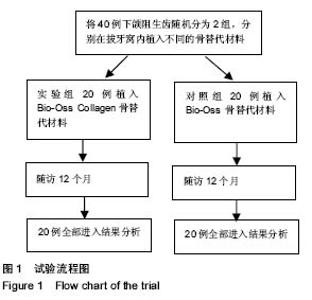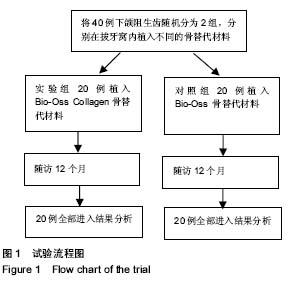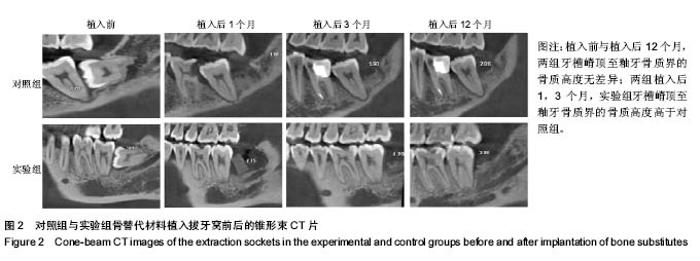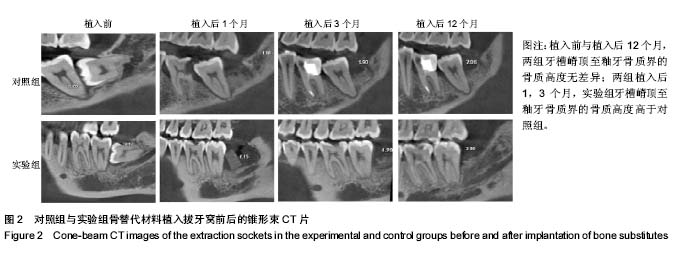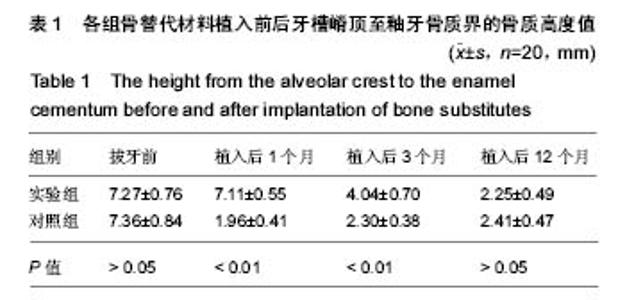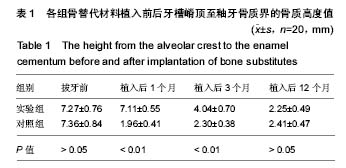| [1]Peng KY,Tseng YC,Shen EC,et al.Mandibular second molar periodontal status after third molar extraction.J Pefiedontol. 2001;72(12):1647-1651.[2]Kan KW,Liu JK,Lo EC,et al.Residual periodontal defects distal to the mandibular second molar 6-36 months after impacted third molar extraction.J Clin Periodontol. 2002;29(11): 1004-1011.[3]牟淋,张敏.Bio-gide膜与Bio-oss骨代材料在引导骨组织再生术中的应用[J].国外医学:口腔医学分册,2004,31(增刊):156-158.[4]黄桂林,程贤书,姜群,等.智齿拔除后羟基磷灰石恢复牙槽骨高度的临床研究[J].口腔颌面外科杂志,2005,15(4):357-359.[5]Jensen SS,Aaboe M,Pinholt EM,et al.Tissne reaction and material characteristics of fur bone substitutes.Int J Oral Maxillofac Implants.1996;11:55-66.[6]王建,胡秀莲,林野.Bio-oss和Bio-oss骨胶原保持牙槽骨量的临床研究[J].现代医学杂志,2009,23(1): 4-6.[7]陈志方,叶茂昌,丁晓红,等.Bio-oss/rhBMP-2复合体修复异种再植牙周围骨缺损的实验研究[J].实用口腔医学杂志, 2007, 23(5):644-646.?[8]陶安军,杨细虎,范广宇,等.引导再生术用于下颌第三磨牙拔除后牙槽骨再生的疗效评估[J].口腔医学,2016,36(11):1017-1019.[9]Araújo M,Linder E,Wennström J,et al.The influence ofBio-osscollagenon healing of an extraction socket: an experimental study in the dog.Int J Periodontics Restorative Dent.2008;(2):123-135.[10]李景辉,杨瑛,张方明.应用位点保存技术预防拔牙后牙槽骨吸收的临床疗效观察[J].临床和实验医学杂志, 2016,15(8):816-818?[11]Zhang DZ,Xiao WL,Zhou R,et al.Evaluation of bone height and bone mineral density using cone beam computed tomo- graphy after secondary bone graft in alveolar cleft.J Craniofac Surg. 2015;26(5):1463-1466.[12]贾赛雄,杜水红,欧春培,等.Bio-Oss骨粉复合BMP-2及VEGF修复大鼠胫骨缺损的实验研究[J].临床与实验医学杂志, 2015, 14(5):349-352.[13]刘进,郭鑫.正畸治疗中磨牙的拔除和保留(二十四)-保留28个牙齿的设计理念[J].临床口腔医学杂志,2007,23(11):699-701. ?[14]李伯友,苏铭扬,李阳,等. CGF联合骨代用品及口腔修复膜在颌骨囊肿手术中的应用[J].临床口腔医学杂志, 2016,32(8): 476-478 [15]Tang Y,Wu X,Lei W,et al.TGF-betal-induced migration of bonemesenchymal stem cells couples bone resorption with formation.J Natmed.2009;15(7):757-765.[16]Carter K,Worthington S.Predictors of third molar im- paction: a systematic review and meta-analysis. J Dent Res. 2016; 95(3):267-276. [17]Rakhshan V.Common risk factors for postoperative pain following the extraction of wisdom teeth.J Korean Assoc Oral Maxillofac Surg.2015;41(2):59-65. [18]杜丽珍.下颌智齿阻生对邻牙牙体牙周组织健康的影响[J].临床医药实践,2011,20(8):587-589. [19]Kim YK,Yun PY,Um IW,et al.Alveolar ridge preservation of an extraction socket using autogenous tooth bone graft material for implant site development: prospective case series.J Adv Prosthodont. 2014;6(6):521-527. [20]Kim JW,Kim SJ,Kim MR.Leucocyte-rich and platelet-rich fibrin for the treatment of bisphosphonate-related osteonecrosis of the jaw: a prospective feasibility study.Br J Oral Maxillofac Surg.2014;52(9):854-859. [21]胡申琳,吴友农,唐卫容,等.第三磨牙萌出情况的全景片分析[J].口腔生物医学,2010,6(2):84-87.[22]黄国伟,庄浩,沈海平.拔牙位点保存技术在口腔种植临床的应用[J].上海口腔医学,2014,23(3):354-355. [23]高朵朵.富自体生长因子纤维蛋白凝胶(膜)促进拔牙创愈合的临床研究[D].河北医科大学,2015.[24]Ozgul O.Efficacy of platelet rich fibrin in the reduction of the pain and swelling after impacted third molar surgery: Randomized multicenter split -mouth clinical trial.Head Face Med.2015;11(1): 37.[25]Lanzm RP,Langer R,Chixk W.principle of tissue engineering : Bone and cartikage reconstruilage rcconstuetion.J Acadpress. 1996;12(2):619-652.[26]Kim BS,Mooney DJ.Development of biocompatible synthetic extrace-llularmatric for tissue engineerin.J Trends Biotechnol. 1998;16(5):224.[27]Beresford JN,Bennett JH,Devlin C,et al.Evidence for an inverserela-tionship betweent the differentiation of adipocytic and osteogenic cellsin rat marrow stromal cell cultures.J Cell Sci.1992;102(2):341.[28]Wakitani S,Goto T,Young RG,et al.Repair of large full thickhessar-ticular cartilage defects with allografts arti cular chondrocytes embedded-din a collagen Gel.J Tissue Eng. 1998;4(4):429-434.[29]龚仁国,阙佳佳,罗纯锐,等.CGF在预防下颌阻生第三磨牙拔除术后并发症中的应用[J].成都医学院学报, 2016,11(1):82-84.[30]王世惟,万蕾蕾,宋萌.Bio-oss 在颌骨囊肿术后缺损中的应用[J].中国口腔颌面外科杂志,2008,6(5):383-385.[31]AntonelloGde M,Torres do Couto R,Giongo CC,et al.Evaluation of the effects of the use of platelet-rich plasma (PRP) on alveolar bone repair following extraction of impacted third molars: prospective study.J Craniomaxillofac Surg.2013; 41(4):70-75. [32]麦昱颖,武辉煌,麦志松,等.磷酸钙骨水泥与聚乳酸-羟基乙酸微球复合物用于拔牙位点骨质保存的动物实验[J].中华口腔医学杂志,2014,49(3):180-183. [33]Uyan?k LO,Bilginaylar K,Etikan ?.Effects of platelet-rich fibrin and piezosurgery on impacted mandibular third molar surgery outcomes.Head Face Med.2015;11:25. [34]Célio-Mariano R,de Melo WM,Carneiro-Avelino C.Com- parative radiographic evaluation of alveolar bone healing associated with autologous platelet-rich plasma after im- pacted mandibular third molar surgery.J Oral Maxillofac Surg. 2012;70(1):19-24. [35]Mozzati M,Gallesio G,Ullio L,et al.Patient-based as- sessment of tooth extraction with ultrasonic dental surgery.J Craniofac Surg.2014;25(6):2081-2083. [36]高秀秋,程焕芝,孙良玉.Bio-Oss骨粉混合PRF修复牙周骨缺损的临床观察[J].医学与哲学,2015,36(10):32-33.[37]Leonardi Dutra K,Haas L,Porporatti AL,et al.Diagnostic Accuracy of Cone-beam Computed Tomog- raphy and Conventional Radiography on Apical Periodon- titis: A Systematic Review and Meta-analysis.J Endod. 2016;42(3): 356-364. [38]黄桂林,程贤书,姜群,等.牙拔除后羟基磷灰石恢复牙槽骨高度的临床研究[J].口腔颌面外科杂志, 2005,15(4):357-359.[39]Ryana HK,Srinath R,Prakash S.Surgical Re-en-try of an Intentionally Replanted Periodontally Compromised Tooth Treated with Platelet Rich Fib- rin (PRF): Hopeless to Hopeful. J Clin Diagn Res. 2016;10(6):ZD01-4. |
